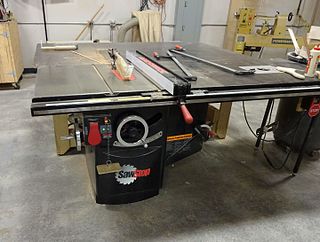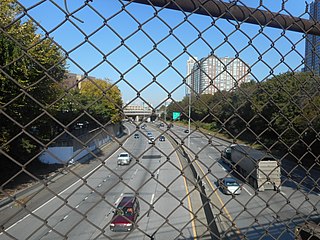
Barbed wire, also known as barb wire, is a type of steel fencing wire constructed with sharp edges or points arranged at intervals along the strands. Its primary use is the construction of inexpensive fences, and it is also used as a security measure atop walls surrounding property. As a wire obstacle, it is a major feature of the fortifications in trench warfare.

The router is a power tool with a flat base and a rotating blade extending past the base. The spindle may be driven by an electric motor or by a pneumatic motor. It routs an area in hard material, such as wood or plastic. Routers are used most often in woodworking, especially cabinetry. They may be handheld or affixed to router tables. Some woodworkers consider the router one of the most versatile power tools.

In agriculture, fences are used to keep animals in or out of an area. They can be made from a wide variety of materials, depending on terrain, location and animals to be confined. Most agricultural fencing averages about 4 feet (1.2 m) high, and in some places, the height and construction of fences designed to hold livestock is mandated by law.

A table saw is a woodworking tool, consisting of a circular saw blade, mounted on an arbor, that is driven by an electric motor. The blade protrudes through the top of a table, which provides support for the material, usually wood, being cut.

A drink can is a metal container designed to hold a fixed portion of liquid such as carbonated soft drinks, alcoholic drinks, fruit juices, teas, herbal teas, energy drinks, etc. Drink cans are made of aluminum or tin-plated steel. Worldwide production for all drink cans is approximately 370 billion cans per year.

A splitting maul also known as a block buster, block splitter, chop and maul, sledge axe, go-devil or hamaxe is a heavy, long-handled axe used for splitting a piece of wood along its grain. One side of its head is like a sledgehammer, and the other side is like an axe.

A mallet is a tool used for imparting force on another object, often made of rubber or sometimes wood, that is smaller than a maul or beetle, and usually has a relatively large head. The term is descriptive of the overall size and proportions of the tool, and not the materials it may be made of, though most mallets have striking faces that are softer than steel.

A baler or hay baler is a piece of farm machinery used to compress a cut and raked crop into compact bales that are easy to handle, transport, and store. Often, bales are configured to dry and preserve some intrinsic value of the plants bundled. Different types of balers are commonly used, each producing a different type of bale – rectangular or cylindrical, of various sizes, bound with twine, strapping, netting, or wire.

A sledgehammer is a tool with a large, flat, often metal head, attached to a long handle. The long handle combined with a heavy head allows the sledgehammer to gather momentum during a swing and apply a large force compared to hammers designed to drive nails. Along with the mallet, it shares the ability to distribute force over a wide area. This is in contrast to other types of hammers, which concentrate force in a relatively small area.

A socket wrench is a type of spanner that uses a closed socket format, rather than a typical open wrench/spanner to turn a fastener, typically in the form of a nut or bolt.

A machine taper is a system for securing cutting tools or toolholders in the spindle of a machine tool or power tool. A male member of conical form fits into the female socket, which has a matching taper of equal angle.

An electric fence is a barrier that uses electric shocks to deter people and/or other animals from crossing a boundary. The voltage of the shock may have effects ranging from discomfort to death. Most electric fences are used for agricultural fencing and other forms of non-human animal control, although they are also used to protect high-security areas such as military installations or prisons, where potentially-lethal voltages may be used. Virtual electric fences for livestock using GPS technology have also been developed.

A fly system, or theatrical rigging system, is a system of ropes, blocks (pulleys), counterweights and related devices within a theater that enables a stage crew to fly (hoist) quickly, quietly and safely components such as curtains, lights, scenery, stage effects and, sometimes, people. Systems are typically designed to fly components between clear view of the audience and out of view, into the large opening, known as the fly loft, above the stage.

A pile driver is a heavy-duty tool used to drive piles into soil to build piers, bridges, cofferdams, and other "pole" supported structures, and patterns of pilings as part of permanent deep foundations for buildings or other structures. Pilings may be made of wood, solid steel, or tubular steel, and may be driven entirely underwater/underground, or remain partially aboveground as elements of a finished structure.

A chain-link fence is a type of woven fence usually made from galvanized or linear low-density polyethylene-coated steel wire. The wires run vertically and are bent into a zigzag pattern so that each "zig" hooks with the wire immediately on one side and each "zag" with the wire immediately on the other. This forms the characteristic diamond pattern seen in this type of fence.

A deep foundation is a type of foundation that transfers building loads to the earth farther down from the surface than a shallow foundation does to a subsurface layer or a range of depths. A pile or piling is a vertical structural element of a deep foundation, driven or drilled deep into the ground at the building site.

A steel fence post, also called a T-post, a Y-post, or variants on star post, is a type of fence post or picket. They are made of steel and are sometimes manufactured using durable rail steel. They can be used to support various types of wire or wire mesh. The end view of the post creates an obvious T, Y, or other shape. The posts are driven into the ground with a manual or pneumatic post pounder. All along the post, along the spine, there are studs or nubs that prevent the barbed wire or mesh from sliding up or down the post. They are generally designated as 1.01, 1.25 or 1.33, referring to the weight in pounds per lineal foot. They are commonly painted with a white tip on top; white improves the visibility of the fence line.

Number 8 wire is a 0.16-inch-diameter (4.064 mm) gauge of wire on the British Standard Wire Gauge that has entered into the cultural lexicon of New Zealand.
A spike maul is a type of hand tool used to drive railroad spikes in railroad track work. It is also known as a spiking hammer.
A post hole clam-shell digger, also called post hole pincer or simply post hole digger, is a tool consisting of two articulated shovel-like blades, forming an incomplete hollow cylinder about a foot long and a few inches wide, with two long handles that can put the blades in an "open" (parallel) position or a "closed" (convergent) position.


















